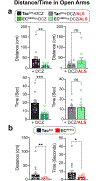Gut enterochromaffin cells drive visceral pain and anxiety
- PMID: 36949192
- PMCID: PMC10827380
- DOI: 10.1038/s41586-023-05829-8
Gut enterochromaffin cells drive visceral pain and anxiety
Abstract
Gastrointestinal (GI) discomfort is a hallmark of most gut disorders and represents an important component of chronic visceral pain1. For the growing population afflicted by irritable bowel syndrome, GI hypersensitivity and pain persist long after tissue injury has resolved2. Irritable bowel syndrome also exhibits a strong sex bias, afflicting women three times more than men1. Here, we focus on enterochromaffin (EC) cells, which are rare excitable, serotonergic neuroendocrine cells in the gut epithelium3-5. EC cells detect and transduce noxious stimuli to nearby mucosal nerve endings3,6 but involvement of this signalling pathway in visceral pain and attendant sex differences has not been assessed. By enhancing or suppressing EC cell function in vivo, we show that these cells are sufficient to elicit hypersensitivity to gut distension and necessary for the sensitizing actions of isovalerate, a bacterial short-chain fatty acid associated with GI inflammation7,8. Remarkably, prolonged EC cell activation produced persistent visceral hypersensitivity, even in the absence of an instigating inflammatory episode. Furthermore, perturbing EC cell activity promoted anxiety-like behaviours which normalized after blockade of serotonergic signalling. Sex differences were noted across a range of paradigms, indicating that the EC cell-mucosal afferent circuit is tonically engaged in females. Our findings validate a critical role for EC cell-mucosal afferent signalling in acute and persistent GI pain, in addition to highlighting genetic models for studying visceral hypersensitivity and the sex bias of gut pain.
© 2023. The Author(s), under exclusive licence to Springer Nature Limited.
Conflict of interest statement
COMPETING INTERESTS
The authors declare no competing interests.
Figures












Comment in
-
Enterochromaffin Cells: Small in Number but Big in Impact.Gastroenterology. 2023 Oct;165(4):1090-1091. doi: 10.1053/j.gastro.2023.05.008. Epub 2023 May 12. Gastroenterology. 2023. PMID: 37178735 No abstract available.
-
Enterochromaffin Cell: Friend or Foe for Human Health?Neurosci Bull. 2023 Nov;39(11):1732-1734. doi: 10.1007/s12264-023-01090-1. Epub 2023 Jul 17. Neurosci Bull. 2023. PMID: 37458959 Free PMC article. No abstract available.
References
-
- Grundy L, Erickson A & Brierley SM Visceral Pain. Annu Rev Physiol 81, 261–284 (2019). - PubMed
-
- Racke K & Schworer H Characterization of the role of calcium and sodium channels in the stimulus secretion coupling of 5-hydroxytryptamine release from porcine enterochromaffin cells. Naunyn Schmiedebergs Arch Pharmacol 347, 1–8 (1993). - PubMed
Publication types
MeSH terms
Substances
Grants and funding
LinkOut - more resources
Full Text Sources
Medical
Molecular Biology Databases

